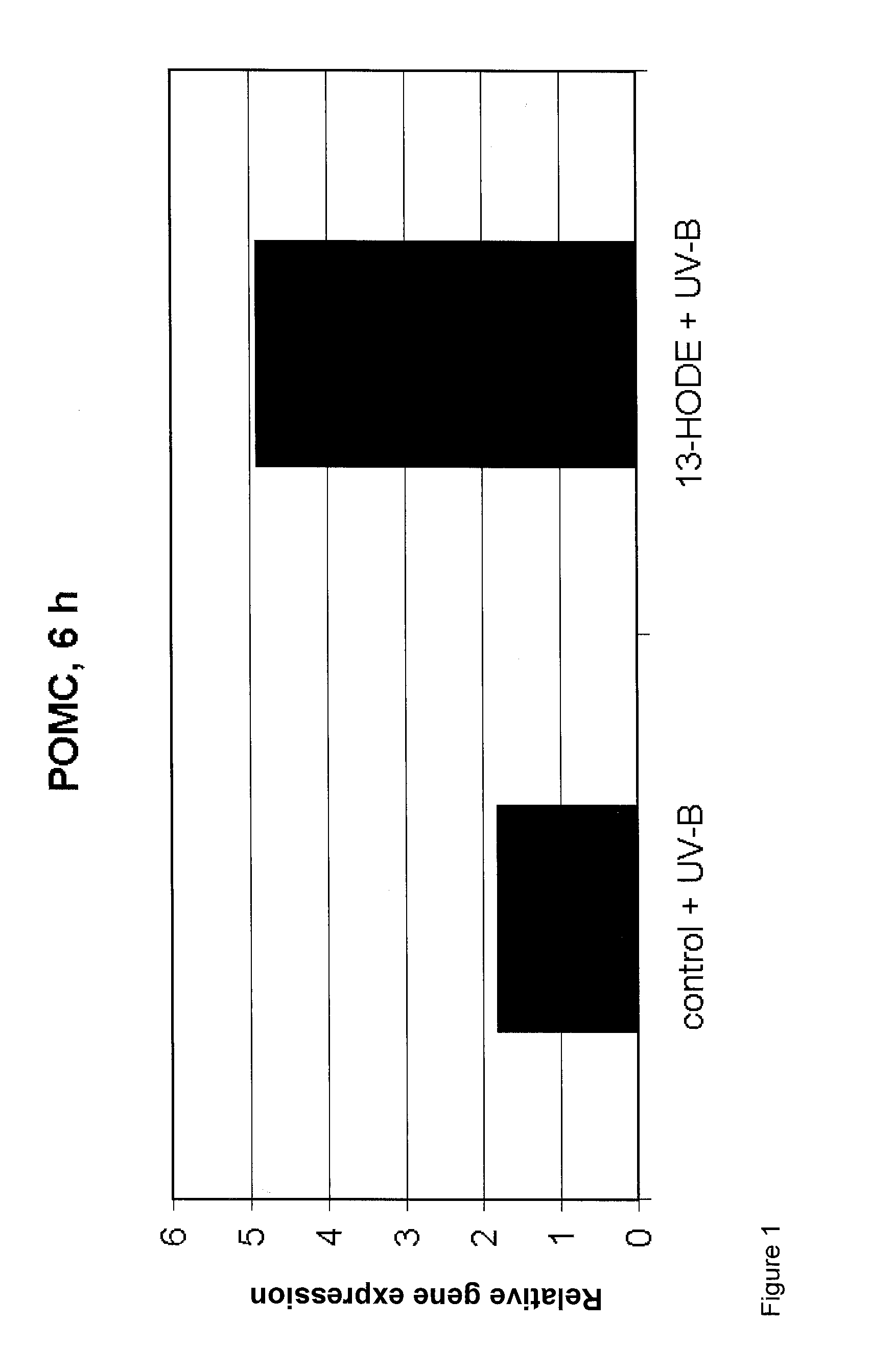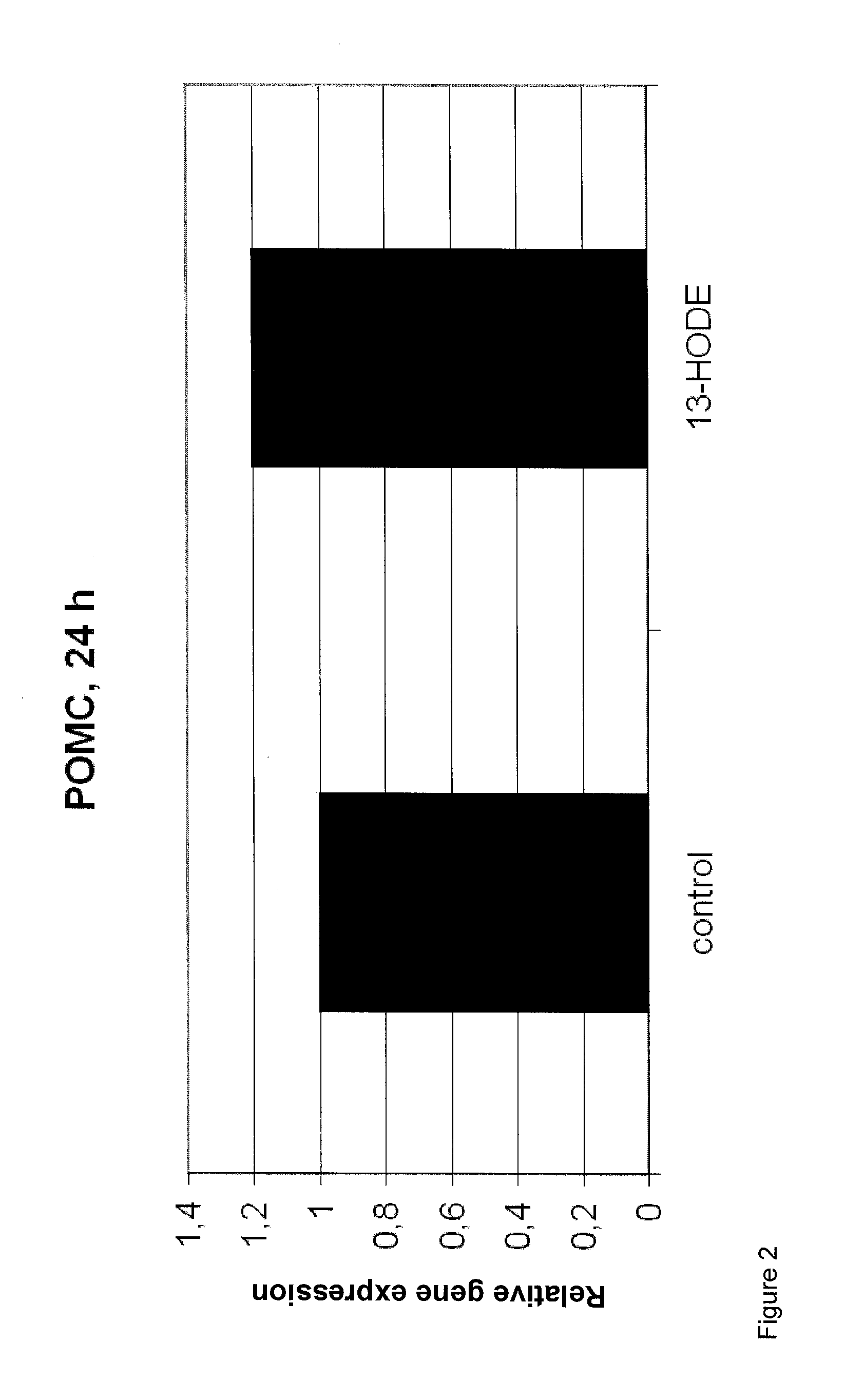Use of 13-hydroxy-9,11-octadecadienoic acid for tanning human skin
a technology of octadecadienoic acid and human skin, which is applied in the direction of hair cosmetics, drug compositions, dermatological disorders, etc., can solve the problems of untanned skin, severe discolouration of the palms of the hand and nails, and untanned skin, so as to increase the tanning of the skin, not develop any undesired odours, and not cause any undesired discolouration
- Summary
- Abstract
- Description
- Claims
- Application Information
AI Technical Summary
Benefits of technology
Problems solved by technology
Method used
Image
Examples
example 1
13-HODE-Stimulated POMC Induction
[0082]In the present example, the effect of 13-HODE on the POMC gene expression in UV-B-stimulated keratinocytes (normal human epidermal keratinocytes, NHEKs) was investigated. For this purpose, firstly primary human epidermal keratinocytes were prepared from neonatal foreskin. The procedure is described in the following publications: Grether-Beck et al., J Invest Dermatol 2005, 125: 545-553; and Grether-Beck et al., Exp Dermatol 2008, 17: 771-779. Subsequently, the cells were cultured in defined serum-free keratinocyte growth medium SFM (Invitrogen, Heidelberg, Germany) with the addition of bovine pituitary extract (Invitrogen, Heidelberg, Germany) and recombinant epidermal growth factor (Invitrogen, Heidelberg, Germany). The cells were incubated until passage 2 or 3 at 37° C. and 5% CO2. For the test as to stimulation of the UV-B-induced POMC gene expression, the cells were sown in 6-well plates and cultured to the point of subconfluence (maximum 7...
example 2
13-HODE-Stimulated POMC Induction without UV
[0090]In the present example, the effect of 13-HODE on the POMC gene expression was investigated in keratinocytes which, in contrast to Example 1, have not been stimulated by prior UV exposure. For this purpose, firstly primary human epidermal keratinocytes were prepared from neonatal foreskin. The procedure is described in the following publications: Grether-Beck et al., J Invest Dermatol 2005, 125: 545-553; Grether-Beck et al., Exp Dermatol 2008, 17: 771-779. Subsequently, the cells were then cultured in defined serum-free keratinocyte growth medium SFM (Invitrogen, Heidelberg, Germany) with the addition of bovine pituitary extract (Invitrogen, Heidelberg, Germany) and recombinant epidermal growth factor (Invitrogen, Heidelberg, Germany). The cells were incubated until passage 2 or 3 at 37° C. and 5% CO2. For the test as to stimulation of the POMC gene expression, the cells were sown in 6-well plates and cultured to the point of subconfl...
example 3
Reduction in the UV-Stimulated Induction of Proinflammatory Marker Genes by 13-HODE
[0096]In the present example, the effect of 13-HODE on the expression of various proinflammatory marker genes in UV-B-stimulated keratinocytes (normal human epidermal keratinocytes, NHEKs) was investigated. The experimental procedure was largely identical to the procedure described in Example 1. Differences consisted merely in the selection of the gene-specific primers for carrying out the quantitative Real-Time PCR.
[0097]The following primer pairs were used in each case:
IL-6:(Seq ID No. 5)5′-AGCCGCCCCACACAGA-3′and(Seq ID No. 6)5′-CCGTCGAGGATGTACCGAAT-3′;IL-8:(Seq ID No. 7)5′-CTGGCCGTGGCTCTCTTG-3′and(Seq ID No. 8)5′-TTAGCACTCCTTGGCAAAACTG-3′;TNF-α:(Seq ID No. 9)5′-GGAGAAGGGTGACCGACTCA-3′and(Seq ID No. 10)5′-TGCCCAGACTCGGCAAAG-3′;COX-2:(Seq ID No. 11)5′-GAATCATTCACCAGGCAAATTG-3′and(Seq ID No. 12)5′-TCTGTACTGCGGGTGGAACA-3′;18S:(Seq ID No. 3)5′-GCCGCTAGAGGTGAAATTCTTG-3′and(Seq ID No. 4)5′-CATTCTTGGCAAATG...
PUM
| Property | Measurement | Unit |
|---|---|---|
| Percent by mass | aaaaa | aaaaa |
| Percent by mass | aaaaa | aaaaa |
| Fraction | aaaaa | aaaaa |
Abstract
Description
Claims
Application Information
 Login to View More
Login to View More - R&D
- Intellectual Property
- Life Sciences
- Materials
- Tech Scout
- Unparalleled Data Quality
- Higher Quality Content
- 60% Fewer Hallucinations
Browse by: Latest US Patents, China's latest patents, Technical Efficacy Thesaurus, Application Domain, Technology Topic, Popular Technical Reports.
© 2025 PatSnap. All rights reserved.Legal|Privacy policy|Modern Slavery Act Transparency Statement|Sitemap|About US| Contact US: help@patsnap.com



